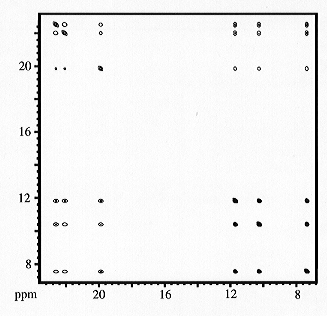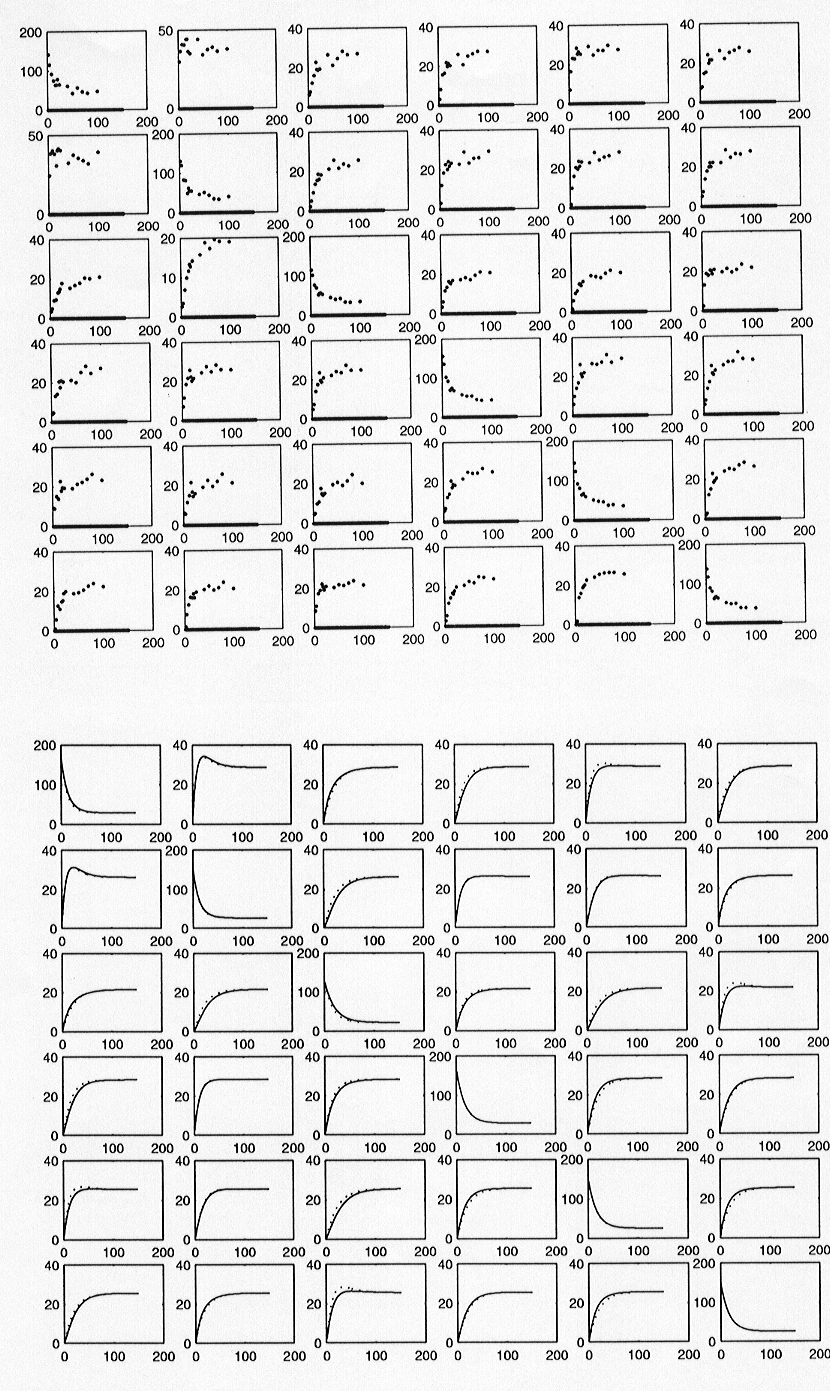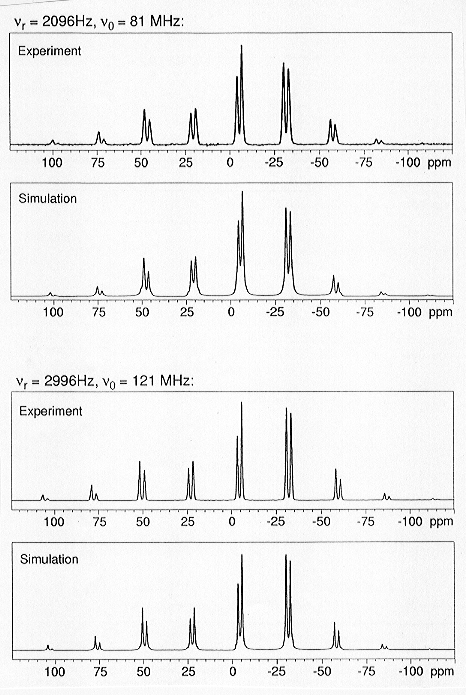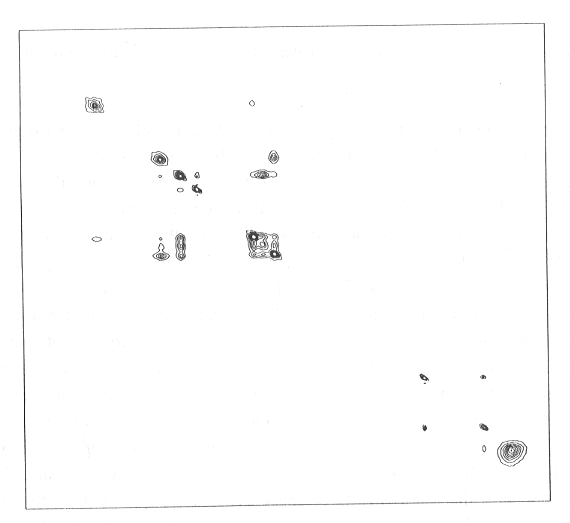

While it is usually straightforward to obtain one- and two-dimensional 31P MAS NMR spectra of polycrystalline inorganic phosphates, extraction of physically meaningful parameters from such spectra is considerably less straightforward, owing to the NMR properties of the 100% naturally abundant spin-1/2 nucleus 31P under MAS conditions. Recently developed new pulse sequences, designed for quantitative investigations of homonuclear coupled spin systems under MAS conditions, in conjunction with suitable numerical methods for data analysis offer new possibilities also for in-depth characterisation of polycrystalline inorganic phosphates. Some examples of applications of such new NMR experiments to ortho- and pyro-phosphates of known single-crystal X-ray structure will be given.
Cd3(PO4)2
Cd3(PO4)2 crystallises in space group
P21/c with six crystallographically independent P-sites in the
asymmetric unit, giving rise to six resolved 31P resonances.
Application of a so-called single quantum - double quantum 2D correlation
31P MAS experiment allows unique assignment of these
six 31P resonances to the corresponding six crystallographic
P-sites from qualitative inspection of the connectivity pattern as is shown
in Fig. 3.8-8. Double quantum coherence is created via homonuclear
dipolar coupling, the excitation efficiency is proportional to the dipolar
coupling strength and is thus a sensitive measure of internuclear distances.
Comparison with known distances from X-ray diffraction yields the unique
assignment from NMR on a polycrystalline powder - which would otherwise
require NMR experiments on oriented single crystals.
 |
Fig. 3.8-8: 31P MAS single quantum - double quantum correlation experiment (in collaboration with M. Feike and I. Schnell/Mainz) on Cd3(PO4)2. On the diagonal "self-correlation" peaks occur; the numbers assigned to the individual 31P resonances A-F in the single-quantum projection refer to the numbering scheme of the X-ray crystal structure. |
Double quantum MAS NMR experiments offer the advantage of also displaying
"self-connectivities", but suffer the disadvantage that quantification
in terms of internuclear distances is problematic for coupled spin systems
of more than two spins. Broadbanded rf-driven 31P MAS spin diffusion
experiments, in turn, do not directly reveal "self-connectivities" but
may be quantitatively analysed also for larger spin systems. Figure 3.8-9
shows such a 2D 31P MAS spin diffusion experiment with a mixing
time of 12 ms for Cd3(PO4)2; Figure
3.8-10 (top) shows the intensities of all diagonal and off-diagonal peaks
as a function of mixing time. The best fit of all experimental 31P
spin diffusion data is compared to the spin diffusion build-up curves as
calculated from the X-ray crystal structure (Fig. 3.8-10 bottom),
showing excellent agreement. Furthermore, these spin diffusion experiments
fully corroborate the assignment of the 31P resonances to
specific P-sites in the crystal structure. Such (and related) 31P
MAS NMR experiments have now been sufficiently carefully explored so that
in a next step these methods can be exploited for the investigation of,
for instance, solid solutions or, more generally, for solids of unknown
crystal structure.
Based on the complete assignment of all 31P resonances in
the 31P spectra of Cd3(PO4)2
it is now possible to use 31P-113Cd double resonance
MAS techniques in order to also assign all 113Cd resonances
to the respective nine independent Cd-sites in the crystal structure. Only
the combined use of selective 31P excitation schemes, followed
by cross polarisation 31P-113Cd from a selected 31P
resonance, using short contact times, yields sufficient site discrimination.
This is illustrated in Fig. 3.8-11. Also two-dimensional 31P-113Cd
MAS correlation experiments are feasible for such assignment purposes.
 |
Fig. 3.8-9: 121 MHz 31P rf-driven MAS spin diffusion on Cd3(PO4)2. Intensities of off-diagonal peaks are a function of mixing times used, the build-up behaviour is characteristic for a given coupled network (see Fig. 3.8-10). |
 |
|
|
 |
|
|
Cd2P2O7
31P MAS spectra of Cd2P2O7
serve as an example that the - usual - treatment of 31P MAS
spectra of solid pyro-phosphates within the framework of a single-spin
approximation is insufficient: the NMR interactions for solid P2O7
compounds are such that at least a two-spin approximation should be used
for the simulation of 31P MAS spectra of pyro-phosphates
in order to correctly account for the MAS frequency and external magnetic
field strength dependent higher order effects in such MAS spectra. Extraction
of the NMR parameters characterising a P2O7 unit
requires spectral simulations using the full Hamiltonian of a homonuclear
spin pair under MAS. This approach affords considerably more involved numerical
data analysis than does the usual single-spin treatment, but has the beneficial
side-effect that the Euler angles, describing the orientation of the 31P
shielding tensor(s) within the P2O7 fragment, are
obtained from easily accessible, simple 31P MAS spectra of polycrystalline
powders. Again, this is information which would otherwise only be obtainable
from 31P NMR experiments on oriented single crystals. Experimental
and simulated 31P MAS spectra of Cd2P2O7
are shown in Fig. 3.8-12; the electronically least shielded component of
both 31P shielding tensors is oriented nearly coincident with
the direction of the respective P-Obridge bond.
 |
Fig. 3.8-12: Experimental and simulated (two-spin approximation) 31P MAS spectra of Cd2P2O7 at different external magnetic field strengths and MAS frequencies. |
SiP2O7 (in collaboration with R. Miletich, and with M. Baldus, R. Iuliucci and B.H. Meier/ Nijmegen)
A refinement of the single-crystal structure of the cubic phase of SiP2O7 in space group Pa3 has been proposed in the literature. This refinement has been questioned since space group Pa3 requires the presence of (some) strictly linear P-O-P units in the structure; the existence or non-existence of linear P2O7 units being the point of disagreement, refinement of the structure in space groups of lower symmetry has been proposed (which then would no longer require the presence of linear P-O-P units). Space group Pa3 requests the presence of 11 crystallographically inequivalent P-sites of the following arrangement and relative amount: one linear P-O-P group with equivalent P atoms, two linear P-O-P groups formed by non-equivalent P atoms, and four different bent P2O7 units made up from inequivalent P-atoms and each unit of a relative amount three. Other conceivable space groups for refinement of the structure would require differing numbers and relative amounts of P sites in the asymmetric unit. Hence, 31P MAS NMR being able (in principle) to quantitatively identify the number of crystallographically inequivalent P sites in the asymmetric unit, should be able to resolve this space group ambiguity. At first glance, simple 31P MAS spectra of SiP2O7 appear to be more or less in agreement with the requirements of space group Pa3, except that the integrated intensities of the various 31P resonances slightly deviate form the predicted values, beyond experimental error. A 31P MAS NMR experiment, undisturbed by the presence of multiple dipolar interactions and considerable 31P shielding anisotropies and which would be able to - somehow - "count" the number of P2O7 units, each made up from inequivalent P atoms, would also immediately resolve the space group ambiguity.
Recently, the NMR-group in Nijmegen has introduced such an NMR experiment
(TOBSY): this pulse experiment achieves polarisation transfer solely by
homonuclear J-coupling. J-coupling is a through-bond interaction, hence
represents a strictly intra-P2O7-unit interaction
and will lead, in a two-dimensional TOBSY experiment, to correlations only
for 31P resonances belonging to the same P2O7
unit and thus allows "counting" of the number of P2O7
units in the asymmetric unit. A 2D 31P TOBSY experiment on SiP2O7
is shown in Fig. 3.8-13, the number of correlations found (5) is
consistent with the requirements of space group Pa3, but there remains
the problem of the not quite perfect agreement of the integrated intensities
in the 31P MAS spectra to be solved / explained. Lower symmetry
space groups, in turn, do not seem compatible with the small number of
TOBSY correlations observed.
 |
Fig. 3.8-13: 2D 31P TOBSY experiment on a sample of the cubic phase of SiP2O7 (sample courtesy of R.Glaum/Giessen). |

Tel: +49-(0) 921 55 3700 / 3766, Fax: +49-(0) 921 55 3769, E-mail: bayerisches.geoinstitut(at)uni-bayreuth.de
 Previous page
Previous page